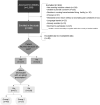Opioid Overdose Risk in Patients Returning to the Emergency Department for Pain
- PMID: 33560418
- PMCID: PMC8633658
- DOI: 10.1093/pm/pnab047
Opioid Overdose Risk in Patients Returning to the Emergency Department for Pain
Abstract
Objective: Using the Risk Index for Overdose or Serious Opioid-induced Respiratory Depression (CIP-RIOSORD) in patients returning to the emergency department (ED) for pain and discharged with an opioid prescription, we assessed overall opioid overdose risk and compared risk in opioid naive patients to those who are non-opioid naive.
Design: This was a secondary analysis from a prospective observational study of patients ≥ 18 years old returning to the ED within 30 days. Data were collected from patient interviews and chart reviews. Patients were categorized as Group 1 (not using prescription opioids) or Group 2 (consuming prescription opioids). Statistical analyses were performed using Fisher's exact and Wilcoxon's rank sum tests. Risk class and probability of overdose was determined using Risk Index for Overdose or Serious Opioid-induced Respiratory Depression (CIP-RIOSORD).
Results: Of the 389 enrollees who returned to the ED due to pain within 30 days of an initial visit, 67 (17%) were prescribed opioids. The majority of these patients were in Group 1 (60%). Both Group 1 (n = 40) and Group 2 (n = 27) held an average CIP-RIOSORD risk class of 3. Race significantly differed between groups; the majority of Group 1 self-identified as African American (80%) (P = .0267). There were no differences in age, gender, or CIP-RIOSORD risk class between groups. However, Group 2 had nearly double the number of predictive factors (median = 1.93) as Group 1 (median = 1.18) (P = .0267).
Conclusions: A substantial proportion of patients (25%) were high risk for opioid overdose. CIP-RIOSORD may prove beneficial in risk stratification of patients discharged with prescription opioids from the ED.
Keywords: Emergency Department; Opioid; Overdose; RIOSORD.
© The Author(s) 2021. Published by Oxford University Press on behalf of the American Academy of Pain Medicine.All rights reserved. For permissions, please e-mail: journals.permissions@oup.com.
Similar articles
-
Evaluating the Risk Index for Serious Prescription Opioid-Induced Respiratory Depression or Overdose in Patients with Cancer.J Pain Palliat Care Pharmacother. 2024 Jun;38(2):131-137. doi: 10.1080/15360288.2024.2348620. Epub 2024 May 9. J Pain Palliat Care Pharmacother. 2024. PMID: 38722684
-
Validation of a Screening Risk Index for Serious Prescription Opioid-Induced Respiratory Depression or Overdose in a US Commercial Health Plan Claims Database.Pain Med. 2018 Jan 1;19(1):68-78. doi: 10.1093/pm/pnx009. Pain Med. 2018. PMID: 28340046 Free PMC article.
-
Longitudinal Evaluation of the Risk Index for Overdose or Serious Opioid-Induced Respiratory Depression in Patients with Cancer.J Pain Palliat Care Pharmacother. 2025 Mar;39(1):51-57. doi: 10.1080/15360288.2024.2427876. Epub 2024 Nov 22. J Pain Palliat Care Pharmacother. 2025. PMID: 39576719
-
Evaluation of an Opioid Overdose Composite Risk Score Cutoff in Active Duty Military Service Members.Pain Med. 2022 Oct 29;23(11):1902-1907. doi: 10.1093/pm/pnac064. Pain Med. 2022. PMID: 35451483
-
Prescribed Dose of Opioids and Overdose: A Systematic Review and Meta-Analysis of Unintentional Prescription Opioid Overdose.CNS Drugs. 2018 Feb;32(2):101-116. doi: 10.1007/s40263-018-0499-3. CNS Drugs. 2018. PMID: 29498021
Cited by
-
Comparing Pain Intensity Using the Numeric Rating Scale and Defense and Veterans Pain Rating Scale in Patients Revisiting the Emergency Department.Cureus. 2021 Aug 27;13(8):e17501. doi: 10.7759/cureus.17501. eCollection 2021 Aug. Cureus. 2021. PMID: 34603880 Free PMC article.
References
-
- U.S. Opioid Prescribing Rate Maps. Centers for Disease Control and Prevention. Available at: https://www.cdc.gov/drugoverdose/maps/rxrate-maps.html. Published March 5, 2020 (accessed October 2020).
-
- Drug Overdose Deaths. Centers for Disease Control and Prevention. Available at: https://www.cdc.gov/drugoverdose/data/statedeaths.html. Published March 19, 2020 (accessed October 2020).
-
- Overdose Death Maps. Centers for Disease Control and Prevention. Available at: https://www.cdc.gov/drugoverdose/data/prescribing/overdose-death-maps.html. Published March 19, 2020. (accessed October 2020).
Publication types
MeSH terms
Grants and funding
LinkOut - more resources
Full Text Sources
Other Literature Sources
Medical


